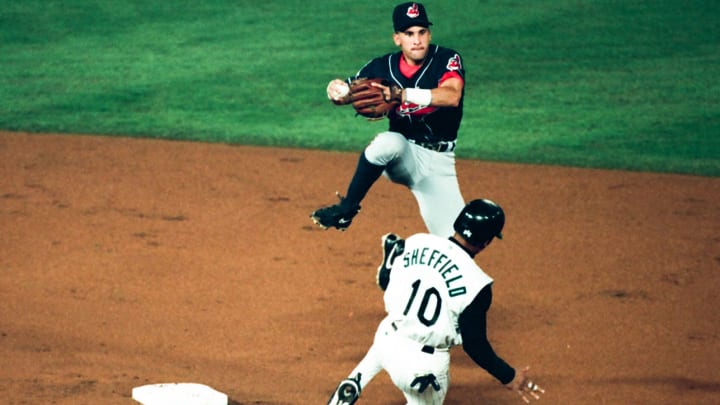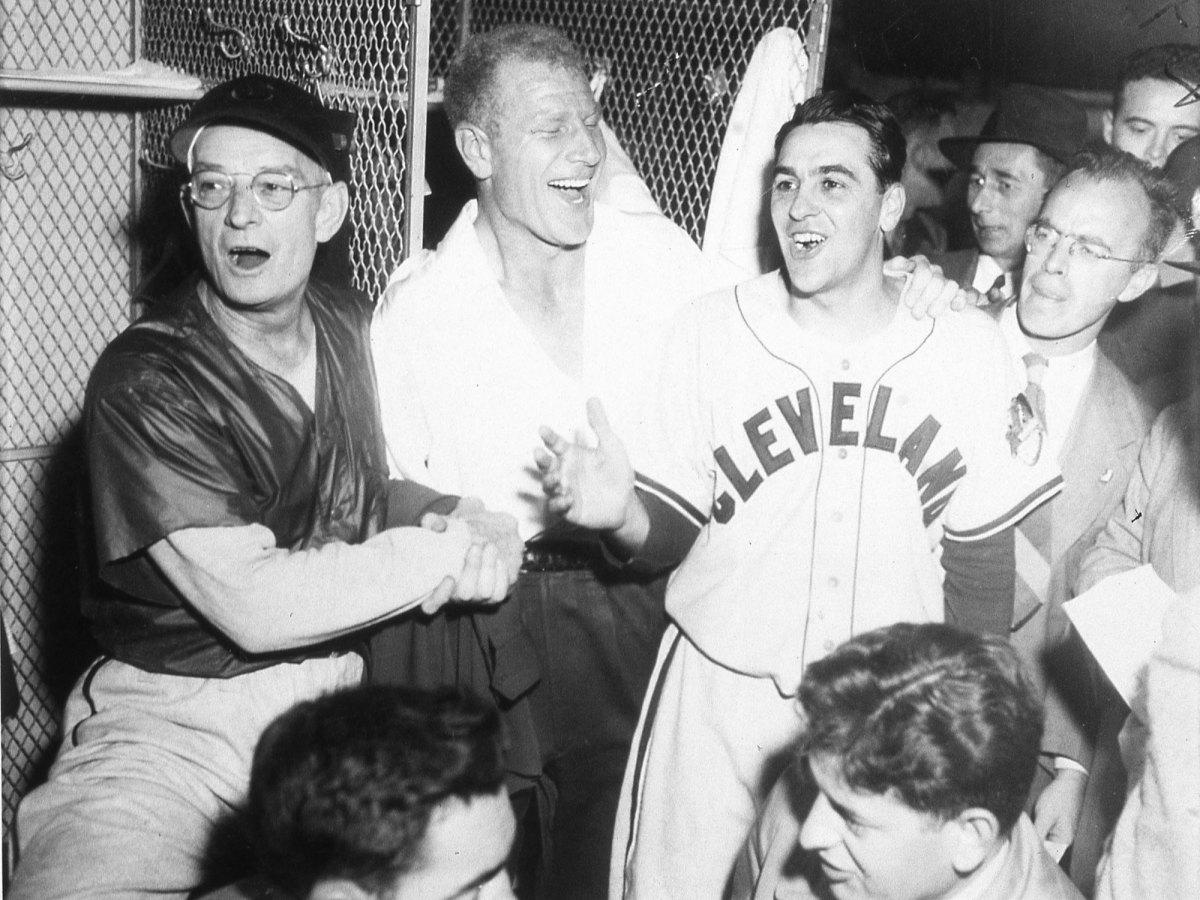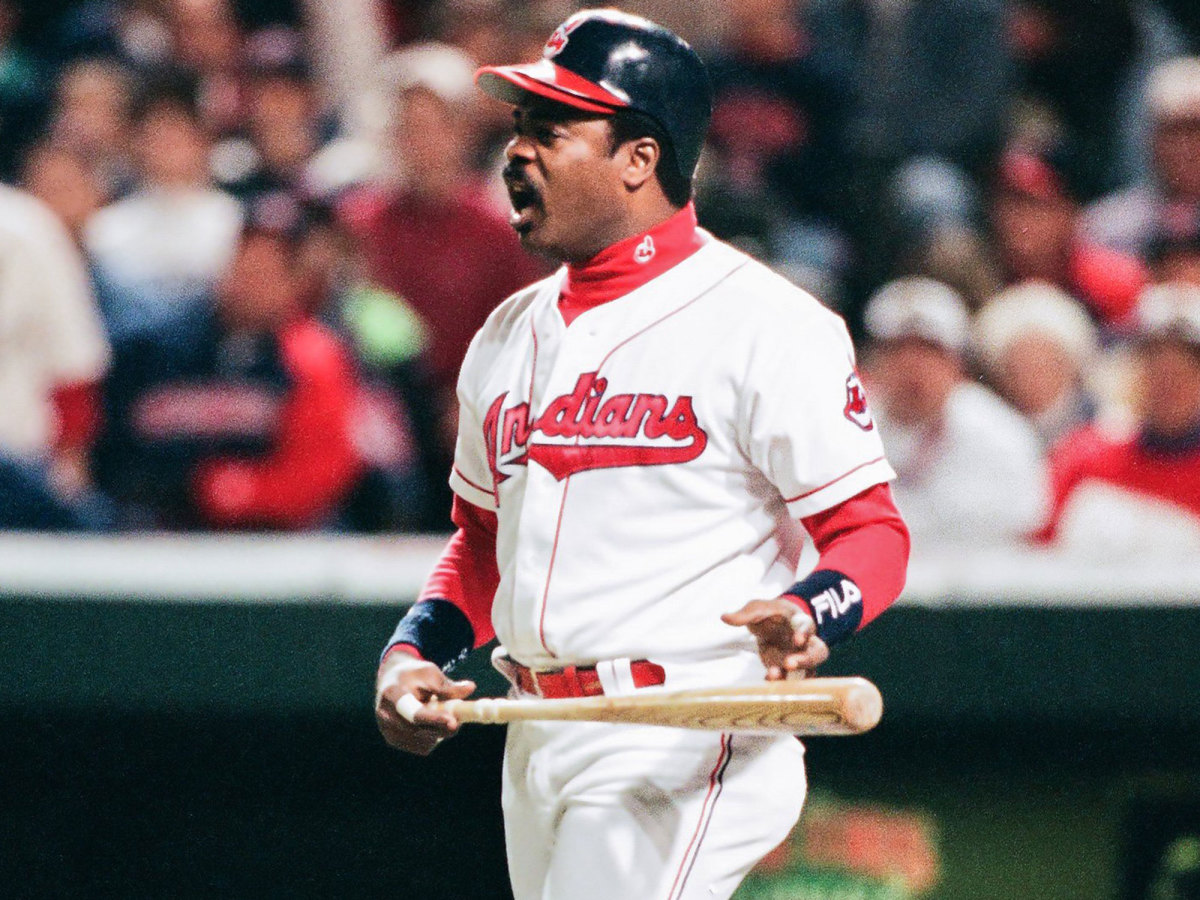Ghosts of October Past: Revisiting Indians' last World Series appearances

The Indians are headed back to the World Series for the sixth time in their 116-year history. It's been 19 years since their last pennant, a drought that's notable but was just the majors' 12th-longest coming into the season—shorter than those of all three other teams in the two League Championship Series. Cleveland's 68-year championship drought, on the other hand, is the sport's second-longest active one behind the Cubs' 108-year dry spell and the fourth-longest in MLB history, behind those of the White Sox (87 years), Red Sox (85 years) and Phillies (77 years).
What follow here is a look back at the team's five previous trips to the Fall Classic, where tragedy begat triumph and juggernauts ran aground.
1920: Beat Brooklyn Robins (Dodgers), 5–2
Known initially as the Blues (1901), Bronchos ('02) and Naps ('03–14)—the last after future Hall of Fame second baseman Napoleon Lajoie, one of the Dead Ball Era's elite hitters—the Cleveland franchise became the Indians in '15. Coined by local sportswriters, the name referenced both the 1914 NL champion Boston Braves and Native American outfielder Louis Sockalexis, who had briefly starred for the bygone Cleveland Spiders before alcoholism took its toll; he died of tuberculosis in '13. Prior to the name change, the team finished as high as second in the eight-team AL just once and lost 102 games in 1914 but broke into the first division in '17. After back-to-back second-place finishes in 1918 and '19, Cleveland won a tight pennant race in '20 at 98–56, outdistancing the White Sox by two games and the Yankees by three. Centerfielder/manager Tris Speaker hit .388/.483/.562 to lead the league's most potent offense, and Jim Bagby (31–12, 2.89 ERA) and spitballer Stan Coveleski (24–14, 2.49 ERA)—like Speaker, a future Hall of Famer—led the pitching staff.
That race had been won under grim circumstances. On Aug. 17, 1920, star shortstop Ray Chapman died of head injuries sustained via a beaning by Carl Mays the day before. The stricken Indians, with 21-year-old callup Joe Sewell at shortstop, nonetheless won 25 of their final 34 games, overcoming a 3 1/2-game deficit behind the defending AL champion White Sox, who were in the midst of being exposed for their World Series-throwing scandal from the year before. Headlines from the grand jury investigation overshadowed those of the 1920 Series.
Indians’ belief in Terry Francona shown in magical World Series run
The series, the second of three in a row played as a best-of-nine, opened at Ebbets Field, where the Indians won the opener, 3–1, behind Coveleski's five-hitter and a pair of RBI doubles by catcher Steve O'Neill off Brooklyn starter Rube Marquard, another future Hall of Famer. The Dodgers took Game 2, 3–0, behind Hall of Fame spitballer Burleigh Grimes's seven-hit shutout and pulled ahead in the series via a 2–1 victory in Game 3, with Sherry Smith spinning a three-hitter. Indians starter Ray Caldwell was chased in the first inning after allowing two runs and recording one out; a Sewell error, one of six in the series, didn't help.
When the series shifted to Cleveland's Dunn Field, the Indians won, 5–1, chasing Brooklyn starter Leon Cadore via a pair of first-inning runs as Coveleski threw another complete game, this time a five-hitter. Game 5, the series' most famous, was an 8–1 win for Cleveland featuring Elmer Smith's grand slam (a series first, done before Grimes retired a single batter), a home run by Bagby (the first by a pitcher in series play) and an unassisted triple play by Indians second baseman Bill Wambsganss (the only one to date). In Game 6, Cleveland won a 1–0 squeaker, as Duster Mails spun a three-hit shutout; George Burns doubled home Speaker in the eighth inning against a tiring Smith. In the battle of spitballers, Coveleski bested Grimes with a five-hit shutout, sealing the championship and becoming the first pitcher in 10 years to win three World Series games.

1948: Beat Boston Braves, 4–2
In 1946, Bill Veeck Jr., the son of a former Cubs president and the planter of Wrigley Field's famous ivy, bought the Indians, who had spent the previous quarter-century meandering around .500, finishing second only in '26 and '40. The next year, in the wake of Jackie Robinson breaking the color barrier, Veeck integrated the AL by signing second baseman Larry Doby, who shifted to centerfield the following year under the tutelage of Speaker because the Indians had Joe Gordon, a future Hall of Famer, at the keystone.
The 1948 squad was laden with Hall of Famers, with Bob Feller and Bob Lemon in the rotation, 42-year-old rookie Satchel Paige in the bullpen and Gordon, shortstop/manager Lou Boudreau and Doby up the middle. The Indians spent much of the first half in first place but faded with a 14–15 July and were 4 1/2 back as of Sept. 6. They won 19 of their final 24 games to finish the regular season 96–58, tied with the Red Sox, whom they beat, 8–3, in a one-game playoff at Fenway Park behind Boudreau's two homers.
Indians’ ALCS celebration gives look inside their family-first clubhouse
The World Series opened in Boston, where Johnny Sain's four-hit shutout bested Feller's two-hit, three-walk performance; the game's lone run was scored in the eighth via a pair of walks, a sacrifice bunt and a single. Behind Lemon's complete game, the Indians evened the series the next day with a 4–1 win as they chased Warren Spahn in the fifth inning. When the series shifted to Municipal Stadium in Cleveland, 20-game winner Gene Bearden spun a five-hit shutout, doubled and scored the first of the game's two runs. In Game 5, witnessed by 81,897 fans (a record that stood until 1959), Boudreau's RBI double and Doby's solo homer backed Steve Gromek's complete game. The famous photo of Gromek and Doby embracing was a milestone unto itself. "At a time when resistance to black players was still intense, it was a signal moment of brotherhood," wrote The New York Times' Richard Goldstein in Gromek's obituary in 2002.
Game 5 was a slugfest won, 11–5, by Boston, with Bob Elliot homering twice off Feller and Spahn throwing 5 2/3 innings of scoreless relief. The Indians rebounded to wrap things up in Boston the next day via a 4–3 victory, with Gordon breaking a 1–1 tie with a sixth-inning solo homer off starter Bill Voiselle. Bearden relieved Lemon in the eighth with two on and a 4–1 lead; he let in two runs, but Cleveland held on to win its second championship.
1954: Lost to Giants, 4–0
Veeck sold the team after the 1949 season in order to fund his divorce settlement, but the Indians remained contenders. After three straight second-place finishes behind the Yankees, they won 111 games—the most by any team from 1910 to '97—with a pitching staff featuring not only Lemon and Feller but also fellow future Hall of Famers Early Wynn and Hal Newhouser. Wynn and Lemon both won 23 games with nearly-identical ERAs of 2.73 and 2.72, respectively. Second baseman Bobby Avila won the AL batting title with a .341 average, and Doby led the league with 32 homers and 126 RBIs.
That squad would have gone down as one of the greatest in history, except that in the World Series against the 97-win Giants, Cleveland just went down—and hard. Game 1, played at the Polo Grounds, featured Willie Mays's over-the-shoulder catch of Vic Wertz's long fly ball, widely considered the greatest in World Series history. Dusty Rhodes's three-run–pinch-hit–walk-off homer won it in the 10th, 5–2. Rhodes again came off the bench in Game 2 to deliver a game-tying pinch single off Wynn, then homered off him in his next at-bat to seal a 3–1 win. The Giants battered 19-game winner Mike Garcia for three runs in three innings in Game 3, with Mays driving in the first run and Rhodes (again) delivering a two-run pinch single. The Giants finished off the sweep by building up an early 7–0 lead against Lemon and Newhouser, highlighted by Mays's third-inning RBI double and future Hall of Famer Monte Irvin's two-run single.

1995: Lost to Braves, 4–2
The next four decades were largely grim ones for Indians fans. Among the lowlights: Herb Score's injury; the trade of Rocky Colavito; the 10-Cent Beer Riot; a 1987 Sports Illustratedcover jinx; and the '89 lampooning of the franchise's futility via the movie Major League. But the team's fortunes took a positive turn when the Indians escaped cavernous Municipal Stadium and moved into Jacobs Field, named for owners Richard and David Jacobs, who had purchased the team in 1986. Led by manager Mike Hargrove and driven by a core of homegrown stars signed to club-friendly deals long before they reached free agency—the brainchild of general manager John Hart—the team embarked on its most competitive stretch in history. Though the 1995 spring lockout shortened the schedule to 144 games, the Indians went 100–44 behind a modern-day "Murderer's Row" featuring Albert Belle (50 homers), Manny Ramirez (31 homers) Jim Thome and Paul Sorrento (25 apiece), Eddie Murray (21) and Carlos Baerga (15), plus speedster Kenny Lofton and slick-fielding shortstop Omar Vizquel.
Watching NLCS Game 3 with—and getting stories from—the ultimate Cubs fan
After sweeping the Red Sox in the Division Series and beating the Mariners in a six-game ALCS, the Indians faced a Braves team featuring a trio of future Hall of Famers in Greg Maddux, Tom Glavine and John Smoltz. In the opener, Maddux held the Indians to two hits and two unearned runs as the Braves took advantage of three straight walks to start the seventh off of Orel Hershiser and reliever Paul Assenmacher, converting those into two runs in a 3–2 win that set the tone for the series; five of the six games would be decided by one run. Despite Eddie Murray's two-run homer off Glavine in the second inning, the Braves prevailed, 4–3, in Game 2, with Javy Lopez's two-run–tie-breaking homer off Dennis Martinez in the sixth the big blast.
At Jacobs Field, the Indians chased Smoltz early and won Game 3, 7–6, on Murray's 11th-inning RBI single off Alejandro Pena. But the Braves broke the series open with a three-run seventh inning against the combo of a tiring Ken Hill and Assenmacher in Game 4, as Luis Polonia hit an RBI double and David Justice added a two-run single en route to a 5–2 win and 3–1 series edge. The Indians stayed alive with a 5–4 win in Game 5 behind homers by Belle and Thome and Hershiser's gritty eight-inning effort opposite Maddux, but they didn't score again. Glavine and Mark Wohlers combined on a one-hit shutout in Game 6, and Justice's home run was all the offensive support the Braves needed to win their first championship since 1957.
1997: Lost to Marlins, 4–3
These Indians weren't nearly the powerhouse that their predecessors were. Their 86 wins made them the only team to finish above .500 in the AL Central, and much of the lineup had turned over in two years: Belle and Lofton departed; Justice, Matt Williams and Brian Giles arrived; and the rotation was serviceable but lacking in frontline talent. The Indians downed the Yankees in the Division Series, then beat the Orioles in a six-game ALCS before facing the upstart Marlins, a fourth-year expansion team.
The series opened at Pro Player Stadium, where behind back-to-back homers by Moises Alou and Charles Johnson, the Marlins piled up seven runs against Hershiser in their 7–4 Game 1 win. The Indians turned the tables with six runs against Florida ace Kevin Brown in Game 2, capped by a two-run shot by Sandy Alomar, Jr., who would collect a series-high 11 hits; Chad Ogea, Mike Jackson and Jose Mesa held the Marlins to one run. Game 3 was a sloppy slugfest; the score was tied, 7–7, going into the ninth when the Marlins erupted for seven runs via four hits, three errors and a wild pitch—enough of a cushion to withstand the Indians' four runs in the bottom of the ninth.
The Indians pounced on Marlins starter Tony Saunders for six runs in two-plus innings in Game 4 en route to a 10–3 win and took a 4–2 lead into the sixth inning of Game 5 via Alomar's three-run homer. But that inning, Hershiser served up a three-run shot to Alou, and the Indians were unable to take full advantage of the eight walks they drew off starter Livan Hernandez, losing, 8–7, despite rallying for three runs in the bottom of the ninth.
With their backs to the wall, the Indians forced the series to its maximum via a 4–1 win, as Ogea hit a two-run single off Brown in the second, then led off the fifth with a double and scored on Ramirez's second sacrifice fly of the game. In Game 7, Hargrove called upon 21-year-old rookie Jaret Wright, who pitched 6 1/3 innings of two-hit ball and departed with a 2–1 lead thanks to Tony Fernandez's two-un single off Al Leiter. That lead held until the ninth inning, but Mesa couldn't close the door, allowing singles by Alou and Johnson and a sacrifice fly by Craig Counsell to tie the score. The deadlock remained until the bottom of the 11th, when Fernandez's error on Counsell's one-out ground ball created a jam. Rookie shortstop Edgar Renteria singled off Charles Nagy, giving the Marlins the championship and sending the Indians to yet another defeat.
